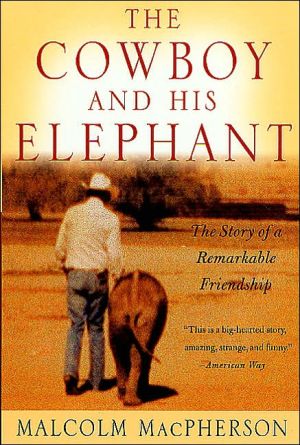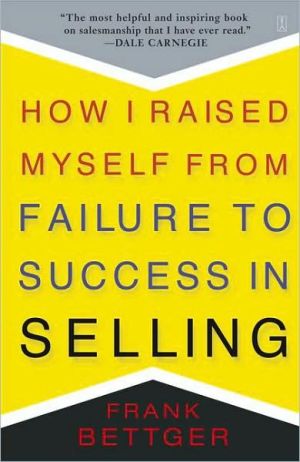The Cowboy and His Elephant: The Story of a Remarkable Friendship
In the late 1980s, a female baby elephant was born on the plains of Southern Africa. In a "cull," her family was slaughtered. Only the newborn female's life was spared. Terrified and bewildered the young elephant was transported to America to be sold.\ Bob Norris is a cowboy with an enormous empathy for animals. Handsome as a movie star, he was the Marlboro Man, with his face appearing on billboards around the world. But something was missing. When the hurt, vulnerable little elephant, Amy,...
Search in google:
In the late 1980s, a female baby elephant was born on the plains of Southern Africa. In a "cull," her family was slaughtered. Only the newborn female's life was spared. Terrified and bewildered the young elephant was transported to America to be sold. Bob Norris is a cowboy with an enormous empathy for animals. Handsome as a movie star, he was the Marlboro Man, with his face appearing on billboards around the world. But something was missing. When the hurt, vulnerable little elephant, Amy, came into his life, an incredible bond between the most unlikely of friends was forged.Bob adopted Amy and through close observation, gentle training, humor, and endless perseverance, this accomplished horseman gradually coaxed Amy into overcoming her mistrust of humans, and her fear of the world. Amy became a beloved member of the Norris family, and partner to the ranch hands, but Bob knew from the start that the ultimate goal was for Amy to regain her confidence and her independence - even, if it were possible, to go back to the savannahs of Africa.Amy may have left the cowboy's life, but she never left his heart. This is a story of mutual friendship, of genuine love and compassion, and foremost, this is an American story with roots that run deep in the values and traditions of the American West. Publishers Weekly Bob Norris was a cowboy, and he also played one on TV. But this former Marlboro Man set himself apart from the pack when he solved his midlife crisis by adopting an elephant named Amy. While Bob had a devoted wife and children and worked with horses, dogs and goats on his ranch in the Rockies, he had started to become disheartened and bored. For kicks, he rented out some of his barn stalls to house six orphan elephant babies taken from a herd in Africa and destined for zoos and circuses. He fell in love with the sickly yet beautiful Amy, and paid $18,000 to keep her. In this straightforward account of Bob and Amy's uncannily close relationship, veteran journalist and author MacPherson (Prot g ) details how Amy cavorted, danced and even purred and made fast friends with Bob's cowdogs and a goat, Michelle, who followed her everywhere. Bob once tried to ride her, but decided he "wanted to keep her untamed nature, her wildness and beauty as an animal completely separate from human interference. He never asked her to carry him again." The story, bolstered by elephant fact and lore, is more captivating than its simplistic, casual prose. Written from the point of view of the elephant, the first chapter reads like a children's book. But intrepid animal lovers will find Amy's unexpected journey at the end of the book rewarding. (May 7) Copyright 2001 Cahners Business Information.
\ \ Chapter One\ \ \ What the old hunter knows is legend. Among all the animals no tighter bond of emotion exists than the one between female elephants, who live with their mothers until they die. Through the ages they have wandered the plains of southern Africa in mother-daughter-grandmother "communions." They have lived for and within one another, with no conceivable distinct existence. Indeed, separation condemns them to a living death by the most painful of means—longing for the herd. Only a special few elephants have ever triumphed over this loss and loneliness. One of them was born in Zimbabwe in the spring of 1988.\ \ \ * * *\ \ \ A short time before her birth, in the last contractions of labor, her mother had squatted on her hind legs, her sides heaving with the weight of her burden. With a bellow and gargantuan groans and sighs she pushed the infant from her womb neck first, with its head tucked between its long forelegs, somewhat resembling a high diver. The light-gray-colored bundle dropped onto the ground with a soft thud and lay in stillness inside the clear wrapping of the amnion. Other elephants looked on, apparently with intense curiosity.\ The mother let out a sigh and a shudder. She extended her trunk and helped her baby escape the sac that had been her world for the twenty-two months since her conception. The infant struggled with an instinctive urgency to steady her own ungainly legs. She slipped in the mud of mixed dirt and amniotic fluid. She raised herself again, but she did not stay upright. Drained by the effort of standing, falling, andfalling again, she tried to raise herself one last time. Now her aunties, as elephant researchers sometimes call older females, rushed in to steady her. With their pointed pink trunk "fingers" they touched her body tenderly.\ With that a fanfare of trumpeting, harrumphs, rumbles, and thunderous stomping and dusting—altogether a raucous celebration—filled the air. The females trumpeted and bellowed, defecated, and ran in shambling circles of pure elephants' joy.\ Hearing the news from afar, relatives from the herd came around. The bulls stood apart, throwing trunks of powder-dry ocher dust in clouds over their heads and rumbling to one another, curious and aloof. They eyed the teenage females in passing to try to judge their readiness to breed. And soon, as always, they lost interest and went back to sparring with their tusks. They posed, huge and majestic, and challenged one another with playful charges and furious dustings, squabbling over who was better than whom.\ The females paid them slight heed. As they fussed over the baby, their displays of genuine caring were as heartwarming as any in nature. The birth brought them great pleasure—or whatever elephants feel when theirs is the world in which a baby has been born. This generosity of spirit reflected some deeper, mysterious, and unique emotion that only some few females of the mammalian species can feel. In this female world of such close community, the newborn was theirs, as if she had emerged from their collective elephant-family womb. The baby was their new daughter, granddaughter, cousin, and niece, but to each elephant of childbearing age, as an individual, she was also her baby alone.\ And what an arrival she was! Shiny and new, tippy on her feet and nearly blinded by the sharp African light, she peeked out from between her mother's legs and uttered her first cry of "Pra-pra," the tiny plaint of a newborn that means "I'm hungry." Her mother gave a soothing rumble from deep within her, and rich, chalk-colored milk dripped from her nipples.\ As a normal and, one might say, beautiful baby, the newborn stood about two and a half feet tall at the shoulders and weighed slightly under 150 pounds. She was battleship gray (bright pink behind her ears), with baggy pink skin bunched at her knees like a child in her grandpa's long underwear. The hair on her head—a frizzy, wine-colored cap—gave her a confused, sleepy look, like someone whom the inconvenience of birth had startled out of a delicious dream. Standing in the shadow of her mother's flanks, she explored her own being with a dubious mien.\ She swayed her trunk as if it were a deadweight. An irritable look in her sharp brown eyes seemed to say, This whatever it is on the front of my face is a mistake. Please, whoever gave it to me, remove it. She had no control over the trunk's finer functions and only a modicum of command over the larger of its forty-thousand muscles. For now it was plainly a nuisance. She stepped on it with a squeak of pain. It got in the way of her mouth, suckling her mother's breasts. She slept on it under her head when she lay down. It altogether seemed to be a bother, and would remain a bafflement for some time to come.\ Her map-of-Africa ears, rubbery and pinned to her head, soon flared and startled her. Their purpose too was hard for her to grasp. She could see them with her peripheral vision, and when their shadows fell on the Kalahari sands, she spooked, screamed, and ran to find her mother.\ Her legs were long, thin, and unsteady. In the coming weeks she would watch the older females cross their back legs at the knees while standing in repose, and when she tried to imitate them, she would fall over on her side. Her legs commanded her in directions she did not wish to go, like someone at the mercy of strong gusts of wind.\ Her broad forelegs were like cumbersome round winter boots encasing the dainty feet of a ballerina on pointe. She could feel herself walking gracefully on tiptoes, but when she looked down she saw only tree stumps. She could not even glimpse her tail, which hung down from the end of her ridged spine like a short hemp strand with a frizzy, blown-apart tip that resembled nothing so much as an exploded trick cigar. Neither could she see around her bowed sides how the skin under her tail and around her back thighs drooped like oversize trousers slipping down to her knees.\ As a whole, if her mother or her aunties had whispered to her in those first hours after her birth that God had drawn her as a silly cartoon, she would have had to agree. She possessed no sleekness, no aerodynamics, no impression of grace or speed or agility.\ Though her mother, as a young adult, had grown into her mature elephant proportions, she, like all elephants, would continue to expand in size and weight throughout her life. She towered over her baby. Nine feet tall at her shoulders and weighing 4,400 pounds, she gave scale to the baby's tiny size and weight. She was the image of what the baby would grow up to be over a long period of physical maturation that parallels the stages of human development.\ \ \ * * *\ \ \ For now, infancy exposed in stark relief the baby's parts: Nothing born should have had such big ears, and a nose like a hose, and such size and girth, and a tail that was hardly worthy of the name. The baby was smaller than most. Ultimately her size might shape her character: She could grow up as a runt or, by compensating for her size with intelligence and a capacity to adapt, she could become a leader. It was too soon to tell.\ But Amy—as she would later come to be called—was already different. Her brownish, amber-colored eyes contained none of the hard darkness of the bulls or the more common dark reddish-black of other females. It was a color said to signify intelligence. Her eyes peered out of her head as if they belonged to another creature inside her baggy skin. Her baffled gaze posed the same enigma that the older female elephants raised when they would pause in unison to look skyward as a cloud floated by. According to the wise old Brahman priests in India, elephants were gods who worshiped the sun and the moon.\ Amy's mother soon grew impatient and took herself several yards from the birth celebration for food and rest. A daughter of the matriarch, she was acknowledged to possess strength and character. She was smaller but more dominant than her sisters, whom she bossed, and they obeyed as if she herself were the matriarch.\ Like all female elephants of every age, she switched effortlessly from watchful mother to distracted child. Lessons for life were surely to be learned in "play," but as the true kings and queens of Africa, elephants lorded over life. They seemed to have leisure, which they used for friendship and gaiety, courtship, reverence—and for itself alone.\ Now Amy's grandmother scooted away the aunties and cousins as if in weary disgust. Their doting over Amy threatened to weaken the baby, whose ability to keep up with the herd was a matter of her survival. The family was migrating in loose association with its herd along the western edge of their territory, inside the 423,000-acre Charisa (in the Sengwa Wildlife Research Area), on the boundary of Zimbabwe's Chizarira National Park. The Sengwa River traversed the Charisa and meandered across a valley floor of escarpments and cliffs of Karoo sandstone before pouring into Lake Kariba, some fifty miles below the falls. Each family member needed sixty pounds of forage daily to satisfy his or her appetite. Wander for food was what elephants did, how they lived, and what consumed their time. It was their job.\ After the hiatus of the birth, the matriarch rumbled a familiar call, "Grah," the "Let's go" signal. The elephants stood still, as if frozen in place. They listened to her calls, and they obeyed her without question. For she alone was their link to the lore of their collective past. She was their leader. Without her they would not know what to think, or do, or where to go. Until the day she died, she was their mother, their compass, their memory.\ With their ears flared, the family set off in single file at a pace to ease the strain on the baby. The aunties guarded the column's rear and flanks against the jackals and hyenas that had already devoured Amy's placenta and sought her out eagerly as a tender meal. Her mother urged her along when she scampered through a forest of legs. Many big eyes peered down and never lost sight of her. Elephants' eyes, with the acuity to spy a tiny morsel on the ground from seven or eight feet high, and to see to their sides—and with a slight movement of their head to their rear—missed nothing, especially not a 150-pound baby careening through their legs.\ No sight could convince an observer of the goodness of their being more than that of female elephants on the march. They showed toward one another what humans would call contentment, joy, and affection. They touched as though they would rather have been there and nowhere else, and with no other creatures. They were at peace. Their world pleased them, as the ladies of the land. They were the world.\ \ \ The baby Amy grew stronger, heavier, taller; and with a widening world, she was learning where she belonged in an order that changed over the seasons by birth, maturity, and death.\ The elephants displayed personalities as varied as any extended human family. Unlike the bulls, who separated from the family when they reached adolescence—in their early to middle teens—and achieved their prominence through physical strength, females found their order through assertiveness, character, intelligence, and judgment; the capacity for memory, and something else mysterious and hard to define. Some elephants remained adolescents their whole lives, forgetful and foolish, while others brooded and stood aloof, and still others sought neither high nor low ground but were content to eat, breed, raise their young, remain a part of the female family, and die.\ The more assertive females stood up to the younger bulls that pestered those females who had already chosen as a mate a more dominant male. These females tolerated no bullying. They stood between their sisters and trouble, and led them away from harm. They worked and lived together as a unit, subsuming individuality, while the males distinguished themselves in more clearly obvious ways, presenting themselves in broad strokes. They were cranky, or outright mean, or sometimes just timid, souls who were terrified of their own shadows, and so on. Males needed to define themselves thus. Females did not. And this made them who they were.\ As a collective of mothers and mothers-to-be, the females spoiled the babies; watched over them; and nurtured, encouraged, and praised them. They did not discipline or punish them for their mistakes. A moment's inattention or a baby's wandering away from the herd to play could mean a life ended quickly. Indeed, the brutality of nature served elephants as discipline served humans.\ \ \ * * *\ \ \ Those who know elephants, work with them, study them, and have hunted them have never doubted their intelligence. One hunter says, "These are special animals. I know it. I'm not a guy who has ever done research. I just kept my eyes open and lived here among them for forty years. They are the most intelligent animals of all, period."\ Amy depended on her elders' intelligence in times of trouble. All elephants got stuck—in mud, in pits, in bowls under the surface of shallow water, in sand. Amy was no different, and she was curious. Once she found herself trapped on a shelf in the river. She could not climb the bank. She screamed her alarm call. Her mother panicked and ran to her rescue. She saw the trouble, and she called the aunties to help her. With patient but insistent coordination, the adults waded into the river and pushed and prodded with their tusks and trunks to lift her up to safety.\ \ \ Years before Amy's birth, when lightning had sparked a wildfire that burned hot and fast, one elephant in the family was seriously scorched, and in her agony she lost the will to flee from the flames. She screamed in pain; she faltered. The other females, heedless of their own safety, rushed into the fire and pushed her to get her out. Her family would not allow her to give up, and she lived.\ Another time, also before Amy's birth, a younger female died of unknown causes. She had not been shot, and she was too young to have died of any ailment of old age. The other females, by their subsequent actions, did not believe that she was dead. They tried to pick her up. They pushed her huge body more than fifty yards into a clump of thick underbrush, where they inspected her all over with their trunks. They pushed at her; they mounted her; they screamed at her, shaded her, and brought her water.\ Some hours went by. Humans arrived, and the elephants fled. The humans removed the dead elephant's tusks, and with butcher knives they cut a large panel of valuable hide off her side, leaving a broad square of bright white subcutaneous tissue exposed to the light. The females returned that night. Clearly upset by what they saw, they set out to "doctor" her. One by one they went down to the riverbank some miles distant and picked up mud, with which they returned to salve the dead elephant's whitened side. And when they were done, and the dead elephant was dark skinned once more, in the eyes of the other elephants she should have been ready to come along with them. They waited. In the morning, when she did not get up, they went on reluctantly without her.\ This remarkable ability to feel distress in their own kind—and also in other, unrelated species—and to try to relieve it sets elephants apart from other species. This compassionate quality certainly impressed Alexander the Great, who fought the Battle of Hydaspes in early summer 326 B.C., in which the Indian monarch Porus was grievously wounded and would have died if the elephant he was riding had not carried him off the field of battle, laid him down on the earth, and with its trunk plucked out the arrows from his body with a gentleness that Alexander described as "human." So impressed was he that later he minted a coin in the elephant's honor.\ Since then, throughout history, the compassion of elephants has intrigued, mystified, and forced on humans a reappraisal of anthropomorphism as a needless and artificial wall between humans and other animals. For the most part women anthropologists (Cynthia Moss, Joyce Poole, Katy Payne, Daphne Sheldrick, and others) have pioneered this sensible, logical view through their studies of elephants, using words like "fun," "silly," "sad," and "happy" to describe aspects of elephant behavior. Sheldrick, for one, says, "[Elephants] have a sense ... that projects beyond their own kind and sometimes extends to others in distress. They help one another in adversity, miss an absent loved one, and when you know them really well, you can see that they even smile when [they are] having fun and are happy."\ A measure of elephants' intelligence is their ability to communicate over long distances through sound frequencies below the level of human hearing. Elephant researchers such as Katy Payne have recorded the sounds of elephants, which some skeptics have dismissed as noise. But the debate over meaning would seem silly to a child, who might reasonably ask, If elephants don't talk over such long distances, why do they have such big ears? In fact these function as biological radiators to cool the blood to an elephant's brain. But is that all? Might not the same ears also scoop delicate low-frequency bundles of sound (messages) out of the air, just as humans' huge parabolic radio telescopes sweep the skies for scintillas of celestial sound (messages)? Why do some think of one as ridiculous when the other is called science?\ \ \ There is no doubt that elephants' sounds had shaken the air above the Sengwa with a warning to Amy's family, then browsing along a southward track within the Lake Kariba watershed, and within the boundaries of the research area. In response the family had shifted farther west. From time to time the older females lifted their trunks high above their heads, sweeping the air for the scent of danger. For verification the matriarch hoisted the end of another female's trunk as if to say, I smell danger. Do you? She acted as if she did not know how to decide. The patterns of the sounds were mixed, and the smells seemed vague. There might be danger ahead, but it had neither a shape nor an identity that the family could understand. And the matriarch relied on the patterns, customs, routes, and rituals that had protected her family before. These new warnings were frightening—without content. For several weeks, while the herd's bulls continued on their southward migration, the females slowed down and listened, and waited until there was silence again.\ \ \ The whole world of Amy's family had not changed for generations, until about fifty years ago, when humans began to farm the lands that were the elephants' traditional migration grounds. The products of human toil and the sun and the rain, the crops were seen by the elephants simply as glorious gifts. The consequences of this misunderstanding would soon spark a tragic chain of events that would change baby Amy's life forever.\ \ \ For now she was learning to become self-sufficient. She still nursed at her mother's breasts, but as she grew and gained weight, she needed occasional food supplements. She watched the adults strip the bark from trees, reach for the higher branches and pull them down, lean into trees with their broad rumps and foreheads and shove them down, pound the dirt bulbs off grasses, and snap the stiff fronds of palms with their tusks. The sound and commotion of their foraging could be heard for a hundred yards.\ More than anything else the elephants in Amy's family—like all African elephants—were eating machines with pass-through digestive tracts that absorbed only a fraction of their foods' nutrition. They needed plenty to get by. And so they cleared the vegetation in their path, almost as though a war had recently been fought there. They did not know the meaning of sharing, and left very little for other animal species that browsed after them. They needed vast tracts of fodder to keep them alive, while every other species down the food chain had to settle for what was left.\ As weeks followed the clays after her birth, Amy's world widened to include her cousins. They roughhoused and heaped up their bodies in elephantine "pig piles" with trumpets of glee. They rammed one another and butted, collided, and rolled over on each other. Play satisfied their need for intimacy through touch. Amy assessed her cousins as individuals with strengths and weaknesses. She was quick to grasp the pecking order. She was growing up to become even-tempered, somewhat aloof, and mature for her age.\ Her older cousins had taught her by example to pull her mother's tail, ears, and trunk. Sometimes when she was tired she leaned against her mother's leg as if it were a convenient pillar. She touched all over her mother's body and stroked her mother's velvety tongue with the fingers of her trunk. In those intimate moments her eyes closed dreamily, and she purred with what seemed like utter contentment.\ Her personality began to develop. For one thing, she was even more than normally reluctant to share. She stole food out of other elephants' mouths with daring and stealth, with which she compensated for her smaller size. She distracted her cousins, then scooped their food into her mouth and walked away as if nothing had happened. She chased and skirmished with zebras, which fled and then stopped, turned, and stared at her. Baboons charged her with loud coughing cries. A plover no bigger than a human's hand, refusing to fly, its feet planted on the dried mud near a wallow and its feathers puffed up, chased Amy away with its strident calls. The wind in the trees, the shadows of clouds on the ground, falling leaves, crawling insects and reptiles, "ghosts" and imagined creatures—almost anything served to give Amy the thrill of fear. Butterflies dancing on the air in balloons of color sent her running, while the older females watched them flutter past with the appreciation of bystanders at a parade.\ Like all young elephants Amy loved the frisson of being chased. In mock terror she trumpeted and shot her trunk straight out in front of her like a lance, with which she parted the high grass as she fled. Out of breath, she turned around and seeing how far she had separated herself from the others, ran in real terror to rejoin them. And when they met and were together again, her limbs, shoulders, and ears went floppy and loose. She shook her head as if in elephant laughter, while the mothers and aunties, standing in the shade of the leafy mopanes, watched and rumbled and nodded as if they approved.\ The whole family played in the wallow—any shallow pan of water mixed with dirt or any riverbank or any watering hole. Glorious mud was all that was needed. On hot days the mud soothed skin that was neither thick nor coarse. To rid themselves of a mosquito, fly, or bee the elephants gyrated, leaped, rolled, ran, and crashed into mud with bellows that sounded very much like those of relief. (If hunger did not take them away constantly in search of food, elephants would probably bathe all day, every day.) A bath in the early afternoon suited Amy's family, and another in the evening. A long drink in the morning and a splash and wade gave the day its start. Water was a luxury as precious as new life to elephants. At its sight, or its scent nearby, they trumpeted and bellowed, and the younger elephants raced ahead and crashed in up to their knees, headless of what creatures had arrived before them. The older females held back, drank and pounded holes in the mudbank with their heels, and splashed mud over their backs and bellies, waiting until the youngsters were ready to eat again.\ At the river's edge Amy timidly rolled over in a slippery bowl of muddy water. It was cool and smelled musty, of decayed vegetation. Her skin glistened with slick mud. It was a world she clearly wished never to leave. But soon she was ready to feed, and when she tried to stand up, her legs slipped, and she fell and slid to the bottom of the pan. With a complete loss of dignity, she finally crawled out and ran to her mother for reassurance.\ The older elephants stayed in the middle of the river and filled their stomachs with enough water to overcome their natural buoyancy. They walked along the bottom as hippos do, breathing through trunks held aloft like snorkels. Trunks waved above the water like black snakes on glass.\ The teenage elephants bathed somewhat closer to the riverbank. They held their heads above the water, braided their trunks in twos and threes, and bobbed like huge black corks. In this weightless world they danced impromptu ballets with sinewy grace. They swam by instinct and could cover great distances in water when the need arose. One family was once observed swimming one hundred miles without a rest, the stronger females giving the weaker ones a lift with their trunks. Their matriarch, it seemed, had led her family on a migration route that had been flooded in the family's long absence by the construction of the Kariba Dam and the subsequent formation of the artificial Lake Kariba.\ Amy—now in her tenth month—still needed her mother to nurture her, but she was found more and more in the company of the family's other females, the aunties and older cousins and sisters, who raised her, protected her, taught her, and played with her. On tree-shaded riverbanks Amy looked at her aunties as if to say, Now this would be a good place for me to roll over, and maybe you could tickle me.\ All elephants clearly loved being tickled, no matter what their ages. Amy was as ticklish as any child. Even the old matriarch enjoyed a tickle now and then. Quick to find playmates, Amy rolled in the grass and split the air with trumpeting sounds of elephant laughter as older cousins played the fingers of their trunks down her ribs and in her armpits and the soft crannies under her chin. At these times the family could lose sight of one another, discovering with a sudden fright that they were being left behind, and they caught up to the other elephants in a hurry.\ When the family met its bond group—the elephants with whom they shared common ancestors—the reunions were extravagant displays of pure elephant emotion. As they came within sight and sound of one another, the families ran and touched and stomped and defecated and twined trunks and bumped foreheads and dusted and clicked ivories. It did not seem to matter if they had met and celebrated like this only an hour before. Elephants could never say hello too often.\ \ \ Their dead were greeted with a show of respect. When they came upon the bones of a blood relative, they always lingered to caress the bones with their trunks. Did they plan their route to intersect with the graves of their fallen family members? Amy watched her mother touch a sun-bleached elephant skull on the ground. She snaked her trunk in the eyehole and brushed over its surface, almost as though she were grieving for the dead relative, remembering her in life.\ Even at her young age, Amy rolled the bones and picked them up and dropped them with a different, even solemn, behavior.\ \ \ Now almost a year had gone by. After plentiful spring rains, Amy's family was reminded of the fields at the bottom of their migration route. Last season while the bulls had eaten the crops of the humans, the females stood at the boundary fence without daring to cross into the forbidden territory. Perhaps this year would be different, and they would feast in the cornfields too.\ \ \ As time went by, Amy was adding one hundred pounds to her weight every couple of months. Everything was happening faster now. She had to use her trunk with greater dexterity to feed herself the foods that she saw her aunties and cousins eat. Sometimes a bouquet of green grass grasped in her trunk ended on the top of her head or draped over her ears. At other times she snatched a leaf or grass directly from her mother's mouth. Eating on her own, she identified the grass by sniffing it: then she pulled it up or broke it off, and brought it up to her mouth and ground it with her molars.\ Drinking frustrated her. Water was hard to hold. She siphoned it into her trunk by breathing in, but not inhaling too hard lest the water go to her head. Then she would sneeze loudly, spraying the air with a fine mist. She practiced sucking water up in her trunk. She learned to raise her head and reach the tip of her trunk up to her lips. The older elephants, who drank without effort, forced the water into their mouths by gently blowing. Amy let gravity work for her. The water drained out of her trunk and dribbled into her mouth. And as she repeated this exercise, she gained proficiency and could be said to drink on her own.\ She was rapidly acquiring social skills as well. Again, as in everything else, she learned by observation, example, and trial and error. She noticed those males in the herd that from time to time came around to check for females in estrous. In comparison to her family members, these males were huge and overbearing, their behavior direct and single-minded. The presence of the males intrigued all the family's females, no matter what their ages. By watching her aunties and older cousins with the males, Amy learned lessons for use later in life.
\ From Barnes & NobleThe award for the most unlikely story of the month goes to this paean to the relationship between one of the original Marlboro Man and an infirm African elephant baby. How the cowboy nursed obese little Amy back to health is the subject of a charming book that James Herriot fans will appreciate.\ \ \ \ \ Publishers Weekly - Publisher's Weekly\ Bob Norris was a cowboy, and he also played one on TV. But this former Marlboro Man set himself apart from the pack when he solved his midlife crisis by adopting an elephant named Amy. While Bob had a devoted wife and children and worked with horses, dogs and goats on his ranch in the Rockies, he had started to become disheartened and bored. For kicks, he rented out some of his barn stalls to house six orphan elephant babies taken from a herd in Africa and destined for zoos and circuses. He fell in love with the sickly yet beautiful Amy, and paid $18,000 to keep her. In this straightforward account of Bob and Amy's uncannily close relationship, veteran journalist and author MacPherson (Prot g ) details how Amy cavorted, danced and even purred and made fast friends with Bob's cowdogs and a goat, Michelle, who followed her everywhere. Bob once tried to ride her, but decided he "wanted to keep her untamed nature, her wildness and beauty as an animal completely separate from human interference. He never asked her to carry him again." The story, bolstered by elephant fact and lore, is more captivating than its simplistic, casual prose. Written from the point of view of the elephant, the first chapter reads like a children's book. But intrepid animal lovers will find Amy's unexpected journey at the end of the book rewarding. (May 7) Copyright 2001 Cahners Business Information.\ \ \ Library JournalWhat do elephant hunters in Zimbabwe, an American cowboy, circus employees, and a worker on an exotic animal farm all have in common? The answer: a young African elephant named Amy. The story starts on the plains of Zimbabwe in 1988 when Bob Norris, a real-life Marlboro Man cowboy, crossed paths with a ten-month-old elephant that had been spared from a large-scale culling operation. A compassionate man who has a way with animals, Bob decided to adopt Amy and integrate her into his ranch life. The book highlights some of their adventures and Bob's ultimate realization that it was just too dangerous to have a large, strong-willed wild animal like an elephant around as a pet. After several years on Bob's ranch, Amy was sold to a couple who trained and performed with circus elephants. The separation was difficult for both Bob and Amy. While Amy's new "family" integrated her into their performances, animal rights activists generated enough concern for the welfare of circus animals so that the couple eventually retired. Amy's life then came full circle under a plan to reintroduce African elephants from zoos and circuses back into the wild. Amy was going home, this time to Botswana. Fans of Born Free will enjoy this heartwarming book; for most public libraries. Edell M. Schaefer, Brookfield P.L., WI Copyright 2001 Cahners Business Information.\ \








